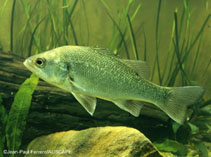| Family: |
Percalatidae (Australian basses) |
| Max. size: |
60 cm TL (male/unsexed); max. reported age: 22 years |
| Environment: |
demersal; freshwater; brackish, potamodromous |
| Distribution: |
Oceania: endemic to Australia (Queensland to Victoria). |
| Diagnosis: |
|
| Biology: |
Occurs in rivers and estuaries (Ref. 7300, 44894). Inhabits lakes and small streams in upland and coastal plain areas, including brackish estuaries. Prefers the cover provided by aquatic vegetation in rocky or gravel-bottomed pools. Only female dwells upstream; male tends to stay in the lower, estuarine reaches of rivers. Juvenile feeds on zooplankton; adult on insects, crustaceans and fishes. Life cycle is catadromous: flood events between May and August trigger a downstream spawning migration to estuaries. A plant thickets and sandbars are known sites for egg deposition (Ref. 44894). A 63 cm LCF female was caught and released in Lake Samsonvale, SE Queensland with an estimated weight of more than 4.5 kg (Stephen T. Poole, pers.comm. elops1@yahoo.com, 03/09). |
| IUCN Red List Status: |
Not Evaluated (N.E.) Ref. (130435)
|
| Threat to humans: |
harmless |
Source and more info: www.fishbase.org. For personal, classroom, and other internal use only. Not for publication.

